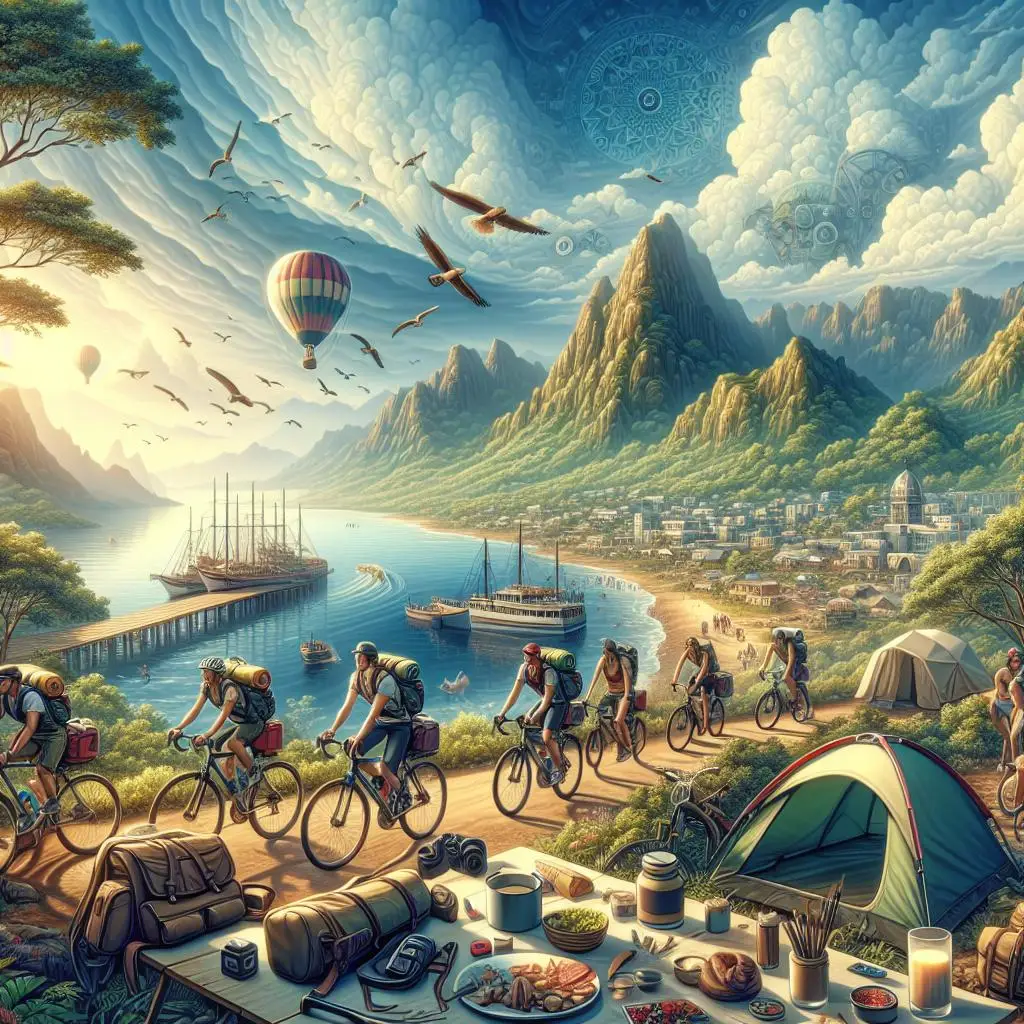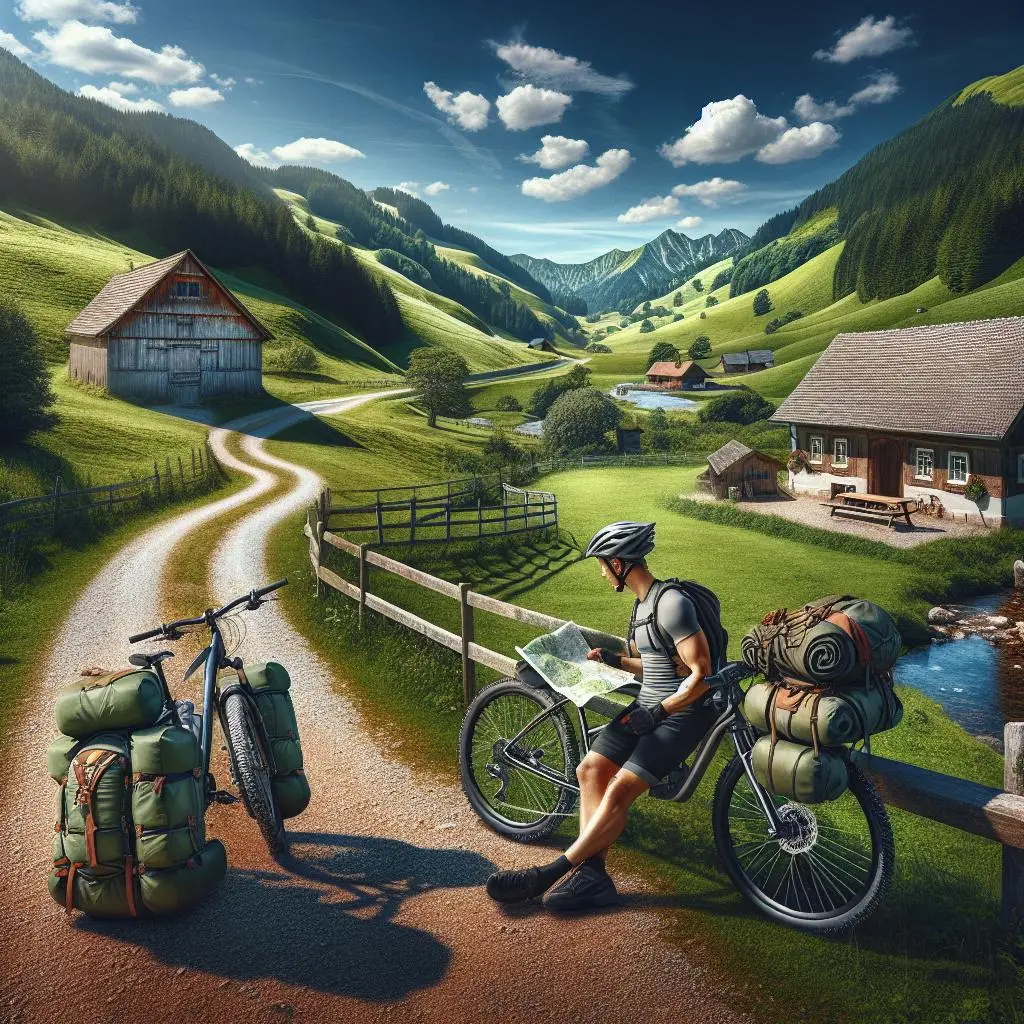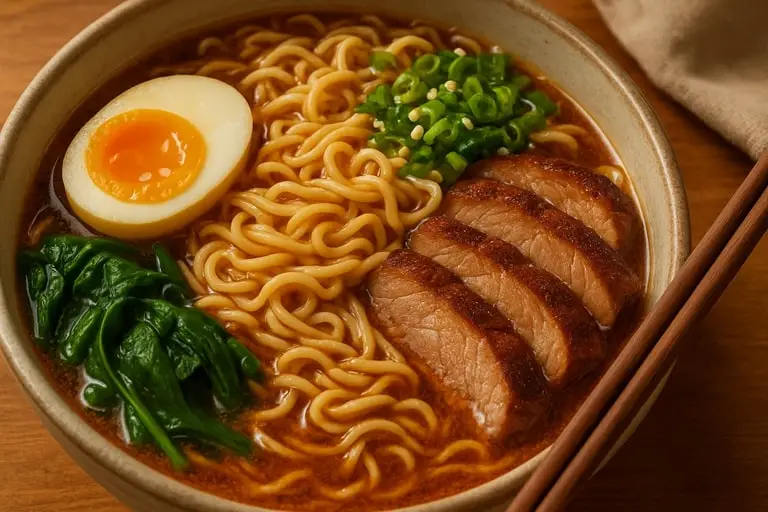Bike travel adventures begin long before the first pedal stroke, in the decisions about why you ride, what you want to learn, and how you’ll keep body, wallet, and spirit in balance over weeks or months on the road. After thousands of miles as a guide and solo rider, I’ve learned that the best trips mix practical frameworks with room for serendipity, letting landscapes and conversations shape the day while a clear plan protects your energy. This balance builds credibility with yourself and trust with those who host or help you, which is the essence of sustainable travel. The result is a style of movement that’s athletic, cultural, and psychological all at once, a craft refined by repetition and reflection.
Route design is where experience pays off, because the “perfect line” is rarely the fastest one and nearly always the one that preserves your motivation and margin. Combining quiet roads with gravel connectors and vetted bikepacking routes yields days that flow, with access to water, shelter options, and scenery that refreshes rather than overwhelms. I build A, B, and C route variations for weather, roadworks, and mood, then share my plan with a trusted contact and local riders for safety and nuance. This approach turns maps into living documents and keeps decision fatigue low when you’re tired, hungry, or negotiating a headwind.
Training for long-distance biking is less about heroics and more about consistency, joint care, and fueling strategies you can repeat under pressure. Treat your weekly base rides like deposits in a fitness bank, add manageable tempo work, and include strength sessions for posterior chain and core so your posture stays strong on climbs and in crosswinds. Practice ride-day nutrition—carbs you can digest at pace, protein to repair—and hydration with electrolytes tuned to your sweat rate, because stomach surprises are magnified when your kitchen is a handlebar bag. When fatigue spikes, deploy micro-rests and cadence variability to protect knees and keep morale high.
Money is a resource like energy, and the trips that last are the ones with a realistic budget and the discipline to adjust on the fly. I start with a per-day baseline covering food, lodging, maintenance, data, and unexpected fees, then add a buffer for rest-day splurges or emergencies, and I revisit it weekly. Field-tested budget bike travel tips include cooking two dinners with one stove session, sharing rooms with other riders you trust, bartering skills for stays, and using loyalty points for urban rest days when prices spike. The goal is to spend with intention so your finances amplify the journey rather than dictate it.
Culture is the heart of the road, and “bike travel across countries” becomes richer when you show up as a curious neighbor rather than a passing customer. Learn greetings and gratitude in local languages, ask permission before photos, and understand meal times and shop siestas to avoid avoidable friction. I keep a tiny gift stash—stickers, tea bags, postcards from home—to reciprocate kindness, and I log cultural cues each night so tomorrow’s interactions are more fluent. This mindful presence turns towns into teachers and coffee stops into stories you carry for years.
Technology should serve the ride, not steal it, so build a minimal, redundant stack and practice with it before departure. Dual navigation options—primary GPS and offline maps on your phone—plus a small power bank and dynamo or solar where feasible keep you independent without chasing chargers. For trust and safety, share live locations with a designated contact, carry ID, insurance, and a translated medical note, and log daily check-ins that require no signal, like a “left camp 07:10” note at reception. Your tools are only as good as your rituals, so audit them weekly to prune clutter and keep attention on the road.
Food is training you can taste, and the best days weave outdoor exploration with satisfying, repeatable meals that pack small and cook fast. My on-the-road kitchen leans on oats, couscous, oil, spices, nuts, and seasonal produce, with instant broth for morale and recovery; dinner doubles as lunch by design. I rotate café visits to support local businesses and meet people, but I don’t outsource my entire appetite, because wind, altitude, and hills don’t respect restaurant hours. This autonomy keeps momentum steady and leaves room for the kind of unplanned detours that define bike travel adventures without derailing your health or budget.
Bike travel adventures for body, budget, and time

Your body is the engine, and in bicycle touring the smartest upgrades often cost nothing: better sleep, smarter pacing, and stronger movement patterns pay dividends when weather or terrain misbehaves. I use a simple RPE scale to cap daily intensity, keep climbs conversational, and avoid the trap of chasing average speed at the cost of consistent recovery. Morning mobility, mid-ride stretch breaks, and evening tissue work make tomorrow’s start feel like a warm-up rather than a reboot. Respecting these limits is not caution; it’s strategy for finishing strong.
Budget is a compass, not a constraint, and it becomes liberating when you align spending with values. Decide what matters most—comfort, food quality, cultural experiences, or gear—and fund those while trimming the rest with meal planning, off-peak lodging, and smart subscriptions you can pause. Track expenses by category every three to five days so drift doesn’t become debt, and adjust routes to align with affordable regions when needed. With this clarity, you say “yes” to the right splurges without anxiety, and your trip lengthens instead of shrinking.
Time is the rarest currency on tour, and keeping a flexible cadence protects both curiosity and consistency. I plan three ride-day templates—short, standard, and stretch—so I can scale to weather, logistics, and mood while still reaching key supply points. Rest days are scheduled but movable, with a minimum of one short day every week to prevent small niggles from becoming big problems and to keep the spark in your cycling journeys. This elasticity lets you ride with people you meet without blowing up your timetable or your legs.
Gear strategy is a story about trade-offs, and adventures in bike travel reward those who think in systems rather than single items. Each piece should do at least two jobs, pack small, and integrate with the rest—rain jacket as wind layer, pot as bowl, phone as backup nav and camera—so your bike handles clean and your mind stays light. Test your loadout on consecutive overnights before departure, log what you never touch, and cut ruthlessly until your setup disappears beneath you. The fewer decisions you must make about stuff, the more you can make about experiences.
Safety planning is not pessimism; it’s respect for the complexity of the road and the people who care about you. I build a medical profile with allergies, baseline vitals, and emergency contacts, keep a photo of my passport and insurance, and carry a compact kit that I actually know how to use. Local laws on lights, reflective gear, and road positioning vary widely, so research in advance and observe what experienced locals do at dusk and dawn. When in doubt, add margin—extra water, a spare layer, and an hour buffer—because margin is freedom when the unexpected shows up.
Storytelling turns mileage into meaning, and it also helps future riders, sponsors, or even your future self understand what worked and why. A simple framework—where you started, what surprised you, one technical lesson, and one human moment—transforms quick notes into narratives that stick. If you create content, pack a routine you can sustain: one photo essay a week or a short daily audio log beats bursts followed by silence, and it’s friendlier to travel adventures bike audiences who appreciate cadence. Document responsibly by asking permission, crediting locals’ tips, and sharing practical details that keep others safe.
Sustainability is both environmental and social, and it starts with choices that shrink your footprint and expand your gratitude. Ride smaller frames of impact by repairing gear, sharing tools, and supporting community bike co-ops, then expand your influence by volunteering or donating route intel to open platforms. Choose businesses that respect the land, refill water at public fountains when safe, and leave camps cleaner than you found them so access remains open. In doing so, you turn private goals into public good, and your bike travel adventures become part of a larger story worth telling.
Stories from cycling journeys and outdoor exploration
On a spring traverse between two coasts, an unexpected detour became a lesson in patience and perspective when a closed pass forced a gravel alternative that wasn’t on my map but was well-known to local farmers. I learned again that humility—asking for directions with a smile, accepting a slower day—beats bravado, and the miles regained their rhythm as clouds lifted over switchbacks. That evening, a mechanic in a village garage trued a wobbly wheel in exchange for coffee and a postcard, proof that skill and kindness travel in both directions. The ride was lighter the next day because I had trusted the road and the people on it.
Crossing borders during a heat wave showed me how “bike travel across countries” is as much about bureaucracy as it is about horsepower, and both reward preparation. Copies of documents, a translation app, and a respectful attitude turned formalities into conversations, and a guard shared a side road with shade that saved more energy than any gel could. The landscape changed languages but not hospitality, and I ended the day at a riverside campground where a family added herbs to my pot and laughter to the evening. In return, I shared route notes for their son’s first two-day tour.
Riding a volcanic island loop on a budget required a different calculus, where water sources and wind shifts mattered more than gradients, and tide charts dictated my camping choices. By morning three, the routine felt like a dance—early climb, swim, nap, then a tailwind glide into a harbor town where a librarian recommended a memoir shelf that now anchors my bicycle travel adventures reading list. Books became waypoints, and I left margin each afternoon to linger with stories that widened my sense of place. The pages turned slowly, and the miles somehow felt faster.
There was a long ridge day that taught me to respect “long-distance biking” as an emotional practice as much as a physical one, because the hardest section began after the summit when fog erased depth and sound. I counted breaths, sang quietly to pace myself, and promised my future self a warm meal if I just held my line to the next wayside. A farmer’s stand appeared like a lighthouse, and a bowl of hot soup restored the world’s edges in minutes. That night, I annotated my map with small hearts where strangers had steadied the day.
In wine country, I learned the value of rest-day improvisation when a festival closed the only affordable lodging and I needed to rethink comfort fast. A café owner pointed me to a retired teacher who occasionally hosted cyclists, and we traded stories over noodles in her courtyard while rain rinsed the dust from my bike. She told me her father had crossed the region by bicycle to deliver medicines after a flood decades ago, and suddenly my trip felt stitched into a longer lineage. The next morning’s climb felt ceremonial, not transactional.
A desert crossing revealed how minimalism is a moving target: I shipped home a redundant layer and upgraded my sun protection in a single town, because conditions were telling me the truth. Lightweight gloves, a better brim, and a looser schedule aligned with the terrain, and I leaned into earlier starts and longer siestas without apologizing to my itinerary. The days regained their joy, and even the headwinds became tutors in cadence and calm. Not every problem is a puzzle; some are just invitations to change.
On my last week, I reflected on why this style of movement keeps calling me back, and the answer was the same one it’s always been: presence. The road strips away the unhelpful, and what remains is a practice that blends fitness, logistics, culture, and curiosity into a life-sized classroom, equal parts joy and discipline. Along the way I’ve seen how bike travel adventures, bikepacking routes, and simple routines can turn ambition into something gentle enough to sustain for years. That’s the gift: a way to keep moving that makes you stronger and softer at once, and a map you can redraw whenever the horizon changes.
Bike travel adventures have become one of the most compelling ways to combine physical endurance, exploration, and personal discovery. For many, the appeal lies not only in the distance covered but also in the unique perspective gained when the world is experienced at the pace of a bicycle. Riders who embark on bike travel adventures discover that each journey is more than a route; it is a narrative of landscapes, cultures, and encounters that leave a lasting impression. Unlike conventional travel, cycling places the traveler directly in contact with the environment, allowing every climb, descent, and stretch of open road to shape the experience in unforgettable ways.
The essence of long-distance cycling journeys is the balance between challenge and reward. Routes often take riders through terrains that test stamina and determination, from mountain passes to coastal trails. Yet the satisfaction of reaching each destination far outweighs the fatigue along the way. Preparing for such journeys requires careful attention to both equipment and mindset. A reliable bicycle suited to the terrain, durable tires, and lightweight gear are essential. Equally important is the mental readiness to adapt when unexpected weather or road conditions arise. Those who seek true bike travel adventures must embrace unpredictability as part of the story, turning obstacles into memories that define the ride.
Beyond the physical journey, cycling across countries or regions opens up cultural horizons that other forms of travel sometimes overlook. Villages off the beaten path, roadside cafés, and spontaneous conversations with locals create an authenticity that packaged tours rarely offer. The slower pace of cycling ensures that landscapes and people are experienced in detail, not just glimpsed from a window. This immersive quality is what gives bike travel adventures their profound richness. Every stop becomes a moment of cultural exchange, and every mile deepens the connection between traveler and place.
Community is another hallmark of long-distance cycling. Many riders form bonds with others on the road, sharing knowledge, encouragement, and sometimes even resources. Organized tours and online groups provide platforms for exchanging tips, mapping routes, and offering support to new adventurers. These networks foster inclusivity, ensuring that no one feels alone during their journeys. The stories of seasoned riders inspire newcomers to take their first steps toward bike travel adventures, creating a cycle of mentorship and camaraderie that strengthens the global cycling community.
Sustainability also plays a central role in the appeal of bicycle journeys. By choosing two wheels over motorized transport, riders reduce their environmental impact, making their travels not only personal achievements but also contributions to ecological well-being. Many adventurers view their trips as part of a broader lifestyle choice: rejecting excess, embracing simplicity, and living in harmony with the landscapes they traverse. In this sense, bike travel adventures reflect both an individual quest and a collective statement about responsible travel in the modern world.
Nutrition, recovery, and pacing form the hidden foundation of successful trips. A diet rich in complex carbohydrates and proteins fuels long rides, while hydration keeps energy steady throughout the day. Stretching, rest, and listening to one’s body prevent injuries and ensure sustainability over long distances. Small habits, like taking breaks at scenic spots or adjusting pace on steep climbs, transform potential struggles into manageable, even enjoyable, parts of the ride. Many experienced cyclists highlight that self-care is just as important as mileage when embarking on bike travel adventures.
In the digital age, technology has enhanced cycling journeys without diminishing their authenticity. GPS navigation, tracking apps, and lightweight gear allow riders to plan efficiently and document their stories. Yet the heart of every adventure remains the direct encounter with the world: the rhythm of wheels against the road, the scent of forests or fields, and the unfiltered sense of freedom that no screen can replicate. These adventures, at once ancient and modern, continue to captivate those who seek more than destinations—they seek transformation through movement.
Ultimately, bike travel adventures remind us that travel is not about how far or fast we go, but about the depth of what we experience along the way. Every ride becomes a chapter in a larger journey of resilience, connection, and discovery. In the simple act of pedaling, riders find a profound way to engage with both themselves and the world, proving that the road less traveled is often best explored on two wheels.













